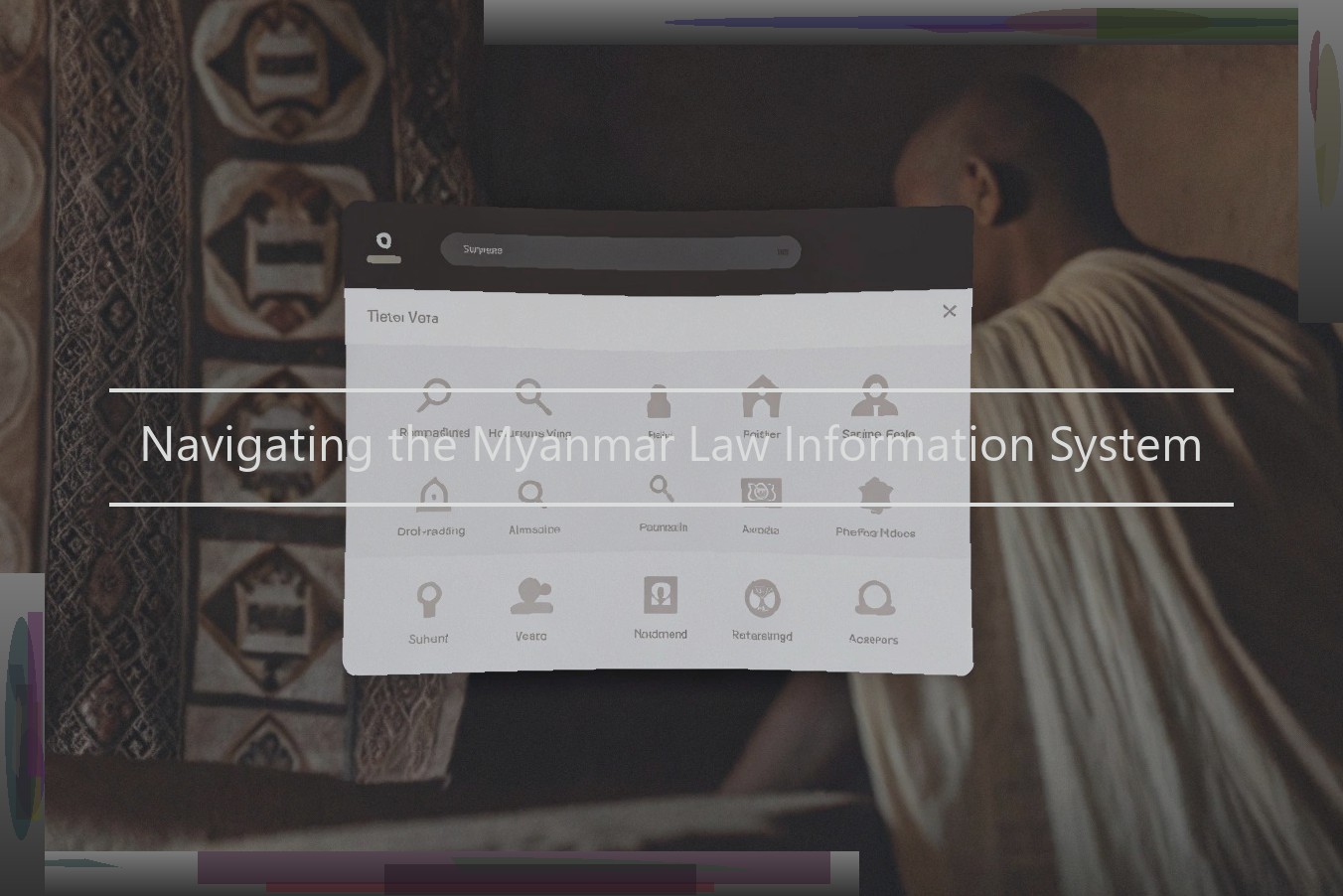Navigating the Myanmar Law Information System
Myanmar Law Information System Overview
The Myanmar Law Information System (MLIS) epitomizes the nation’s deep commitment to the rule of law and to the (re-)establishment of transparent, democratic governance. Through the MLIS, the public has access to "the complete and accurate records of all laws of Myanmar" via the Internet. The Law Information Unit within the Myanmar Constitutional Tribunal (MCT) is responsible for the MLIS, and is to ensure that new legislation will continue to be added promptly. The system is to be maintained through collaboration between the MCT and the Law and Human Rights Department within the Ministry of Home Affairs.
The MLIS contains all enacted laws of Myanmar that have been made available since the 1940s , totaling more than 3,000 documents. The website is powered by the .mm ccTLD. As a condition of access to the website, users must agree, via a pop-up screen, to their acceptance of the website’s terms and conditions, including acknowledgement that the laws made available through the MLIS are a "record for historical reference" only. Although the documents are presented in jpg format, rather than in HTML format, they are searchable online.

System Features and Capabilities
The central gateway to the online service for Myanmar Law is through the homepage for the site. The site is in Burmese Script and requires a Unicode system font to be able to be read correctly. The site entry page gives a choice of search methods to retrieve material, including a Boolean style search engine. In terms of ease of use however, many people may find that the "Simple Search" function is more appropriate in finding their way into the system. Use of the "Browse" option will ultimately lead you back to the search features of the system. This is so because the product bibliography leads you back into the search criteria of the system, even if there was a button to access the bibliography directly from a parallel page in English. The search engine has a range of options which allow for use of keywords, document type, document number or date. To a certain extent this is similar to the "Find Law" search engine used by Legal Information Institute in the USA. To run a simple search users can use key words, search by document type (laws, notices, rules and regulations) and/or document date. The system is allowing for both English and Burmese script to be entered into the search fields. The system appeared to best perform when searching using the section number (e.g. 360, 362(b), 360(3), 359, etc.,). Using the search function will deliver a list to further "drill down" into the system by using the search parameters against a set of results that will link you to the point of interest in the law being examined. On the basis of this Beta system, a user should also be able to find their way into the legislative system in something approaching their own language. This has been periodically a difficult task for even ordinary or trained lawyers when they have had to piece together a series of numbers to get around perhaps to the next law or regulation that needs to be examined for purposes of compliance with a foreign legal question, such as "What is the process in Myanmar for registration of an investment?" While, in this simple search above, I have attempted to give you some pointers, I suspect that it will take some initial work that is iterative to find your way around the system initially. From that time onward, I think that the system will be of assistance. The table of contents is also available in an outline which can be opened up onto a blank page. This will be particularly useful for survey purposes or if there is a necessity to examine the system in English language.
Advantages of the System
The Myanmar Law Information System provides a number of benefits to its users. One of the most significant advantages of the system is its accessibility. Unlike traditional printed law books that may be difficult or impossible to come by, the system is readily available online to anyone with internet access. This makes it truly accessible to everyone, anytime from anywhere in the world. Moreover, unlike other outdated Myanmar law information websites that are difficult to use and often inaccurate, the Myanmar Law Information System is simple and easy to use. Third party websites cannot compare to the completeness of law documents and statutes found in the Myanmar Law Information System. The advantages of the Myanmar website come from the comprehensiveness and accuracy of the law documents and statutes provided on the site, which are undoubtedly missing or inaccurate on other websites. In addition, the Myanmar Law Information System offers a search function that allows users to efficiently retrieve specific law documents and statutes. This feature not only saves valuable time but also increases productivity by making legal research fast and simple.
Accesing and Utiliziing The System
To access the Myanmar Law Information System (MLIS), simply use the following link (www.mlis.gov.mm). The MLIS was developed by the Myanmar Government in 2011 to disseminate laws in Myanmar to the public. The MLIS is also known as the Myanmar Law Resource Center (MLRC). It contains laws, rules, bye-laws, orders, notifications and proclamations in force since independence in 1948. In addition to providing a full text of the laws, the MLIS gives users the option of searching by (i) subject of law; (ii) language used (myanmar, english or bilingual); and (iii) types of law such as constitution, promulgated international agreements etc. The current versions in use are maintained on the MLIS for public reference. However, the older versions can also be accessed by the public from the MLIS. In May 2016, prior to the new government taking power, the MLIS had over 17,700 documents in the MLIS provided in digital format for public access, free of charge.
System Updates and Improvements
One of the issues we raised a few months back when discussing the Myanmar Law Information System (MLIS) was that the interface had not really changed much over time, and that it was difficult to search or even view documents after they had come into the system. We understand from a report released by the Government of the Republic of the Union of Myanmar – Ministry of Information that this has now changed, with the system having been upgraded to allow users to search the entire system by a variety of criteria, including by keyword and by a custom time period.
The MLIS is being developed, according to the Report, following best practices and information technology standards with the goal of securing the integrity of official documents contained in the database and recognizing and protecting copyright of authors. This is all to be welcomed. There is now some hope for example that mapping in law firms and through internal legal teams can be done based on the primary jurisdiction of a document. There have long been digital law systems in place, but managing them for the purposes of cross-border deal teams has long been problematic. The other big gain here is from improved searching through regular updates of documents that have transparency and an understanding of the time of their publication .
The report notes that the MLIS is anticipated to be developed as a fully-fledged online digital library, with users able to search, collect and download documents as necessary. We note that one improvement has already been made to the system in relation to access by commercial entities, permitting individuals and corporations to register to gain access to specific documents. In the past only government personnel were allowed to do this, but private entities can now also access documents and specific laws and notifications for a monthly fee. It is also possible to apply for an annual subscription to access rights to the system.
We will be exploring some of these new changes in the coming weeks now that we have properly found our feet and stopped using old versions of the site in most of our research. There have long been questions over the practicalities of relying on a system and one of the clear gains of the MLIS in the past has been to provide a local source of terms for legal dictionaries used in the region. This has less to do with accuracy of a term, and more to do with practical usage that would be difficult to find elsewhere.
System Challenges and Limitations
Despite its many promising features, the Myanmar Law Information System is not without its limitations. For instance, certain content appears incomplete. The website claims to have all relevant laws and regulations from 2012, but this has not yet been fully implemented. Prior regulations are in the process of being translated. At present, the database does not include regulations predating 2012, which may prove problematic for legal practitioners in Myanmar, who are often required to reference old laws for context. The site also does not include any features for quickly searching across and comparing both individual laws or regulations and the text of multiple laws and regulations together. This will hopefully be updated as more content becomes available on the site. Overall, it is apparent there are still some technical glitches that need to be addressed.
Future Developments and Improvements
Additional topics for the site could include a glossary of legal terms, white papers on specific legal issues, links to related legal blogs and sites, discussion forums, or other such material to be developed over time. Such additions could provide valuable supplemental materials that explain complex rules and procedures in detail. The ability to post recent appellate decisions, as well as scanned images of the decisions themselves , would add yet more functionality and utility to the site. Over time we anticipate that the topic and interests covered by the site will develop and adapt to changes in the legal environment. Over time it is anticipated that additional industry input will be received concerning the scope of information that should be covered by the system. The goal is to make the database as comprehensive and user-friendly as possible, and to expand its scope according to market needs. Wherever there is demand, the capability to implement functional enhancements is being made available to facilitate the continuous improvement of the Myanmar Legal Information System.



